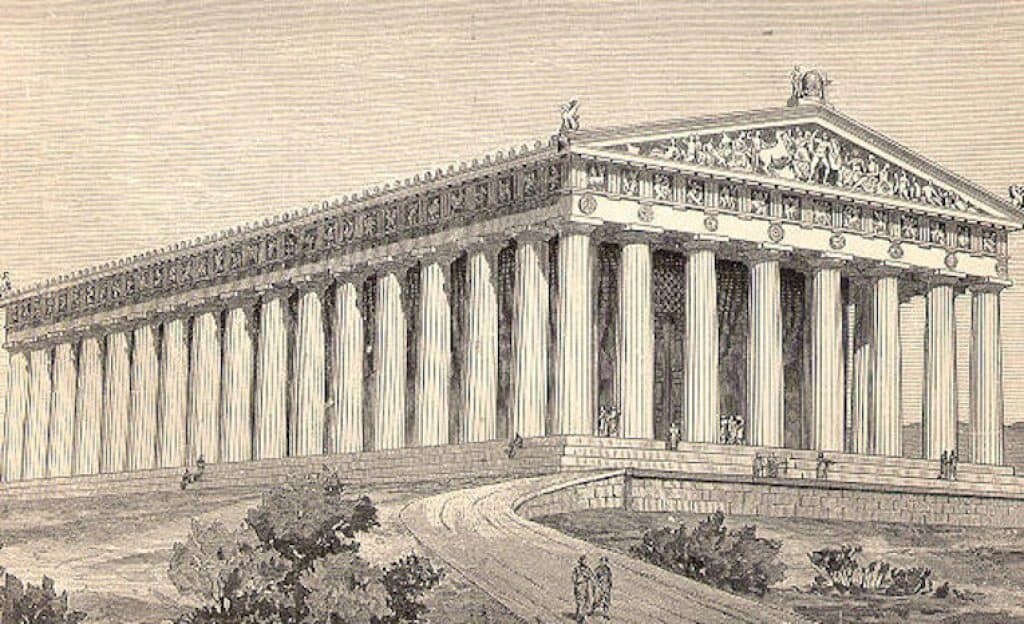It is a familiar structure and a hallmark of classical Greek architecture: the Parthenon, originally built in honor of Athena, patron goddess of Athens. Construction started in 447 BCE and was completed by 438 BCE. It featured tall columns and the building stretched to 228 feet by 101 feet. Scholars believe that it was built on the site of an earlier temple to Athena, one that was destroyed by the Persians at some ancient time.
The timing was right. During the 4th and 5th centuries BCE, Athens became a central power in the Grecian area and was an important site for the arts and commerce.

The building of the temple was costly and labor-intensive. Huge slabs of marble had to be moved from Mount Pentelicus to Athens, a journey of ten miles. Additionally, an article in Smithsonian magazine states that the cost was 800 silver talents, which was “a considerable sum in an age when a single talent could pay a month’s wages for 170 oarsmen on a Greek warship.”
You May Also Like: Mysterious Iron Pillar of Delhi
For a structure that was meant to last forever in honor of a Greek deity, the Parthenon has seen its share of battles and multiple owners. In 276 CE, Heruli pirates destroyed much of Athens, including the Parthenon. Approximately 100 years later, the structure was repaired, most likely during the reign of Roman Emperor Julian the Apostate (332 – 363 CE).
After Christianity replaced the ancient Greek religion in the area, the Parthenon became a church dedicated to the Virgin Mary—and in the 15th century, the building became a mosque for a time.
Later, in the late 17th century, the Ottoman Empire’s army conquered Greece and held little regard for the heritage sites such as the Parthenon. The Turks used the building as a storage facility for gunpowder, and soon after a Venetian mortar round destroyed much of the inner temple, killing almost 300 people.
But the Parthenon is not solely the property of war scholars and cartographers. The building is full of mysteries that continue to puzzle historians and archeologists to this day.
When modern scholars began studying the building, they noticed that some of the marble blocks fit together with open spaces of a millimeter or less between them. How was this possible without modern tools?
Also, the building employs the use of several optical illusions. To correct for imperfections of our sense of sight, the columns were widened by a few inches in the middle to make them appear absolutely straight, and the floor dips slightly toward the center to give the appearance of a clean and flat surface.
In modern times, the building and its decorations have become the victims of “civilized looting.” In the early 19th century, a Scottish Earl removed several of the statues from the site, saying he did so with the permission of the ruling Ottoman Empire. The modern Greeks disagree and are trying to get the statues back. The statues of dispute are currently housed in London’s British Museum.
Not forgetting the floor and the columns and the block alignment, the biggest puzzle is the timeline. According to ancient records kept by officials, it took eight to nine years to complete the building of the temple. This is almost too much to believe. A similar site in modern-day Turkey, a temple to the Greek god Apollo, took more than 600 years to create and was never finished. The repair work of the Parthenon has, to date, taken 34 years and is still ongoing. Skilled workmen can take up to three months repairing and/or rebuilding a single marble block.
How were ancient peoples able to construct such a “perfect” building in such a short time—much shorter than modern craftsmen and modern tools can do similar work today? The Greeks of that time must have either had multitudes of workers toiling away at the single site or perhaps had a little help from the gods.
Sources
“Unlocking Mysteries of the Parthenon” Smithsonian magazine![]() , February 2008
, February 2008
“Parthenon” Wikipedia, pulled 5/12/16